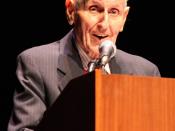Everyone knows the name Dr. Jack Kevorkian since the media placed him in the public eye for his actions involved with euthanasia. He has assisted in the deaths of hundreds of patients. The Merriam-Webster dictionary defines euthanasia as "the act or practice of killing or permitting the death of hopelessly sick or injured individuals (as persons or domestic animals) in a relatively painless way for reasons of mercy." The controversial issue of euthanasia is a very involved moral, social, religious, and political battle. Euthanasia, in its many forms, involves the sacred essence of a human life which creates mixed views if it is an allowable action from many diverse points of view, however ultimately it is that person's life and that person's decision.
There are three main types of euthanasia, or mercy killing, in existence in the world today. The first main type is a physician-assisted suicide while the other two are active and passive methods of euthanasia.
Physician assisted suicide is when a doctor supplies the patient with the proper information, procedure, and or tools that allow the patient, themselves, to terminate their own lives with ease. Active euthanasia is where there is a deliberate action to end the life of a dying patient to avoid further suffering. Active euthanasia can be broken down into two categories: voluntary and involuntary. Voluntary euthanasia is when a doctor gives a dying patient a lethal injection at the request of the patient to end the patient's life. Involuntary euthanasia is where a doctor gives a dying patient a lethal injection to end his/her life without a specific request for the action. Finally, there is passive euthanasia which is allowing a person to die of natural causes and to not do anything to attempt to save that person's life. Two examples of passive...


